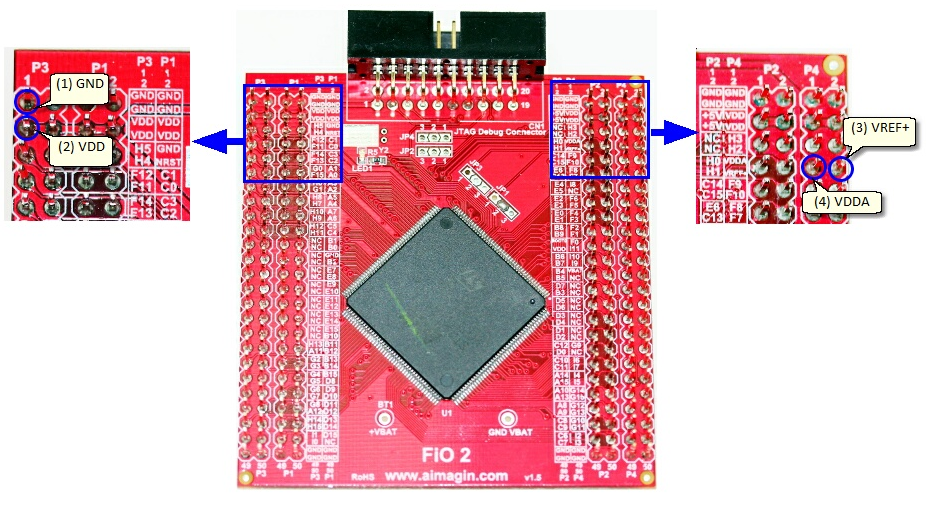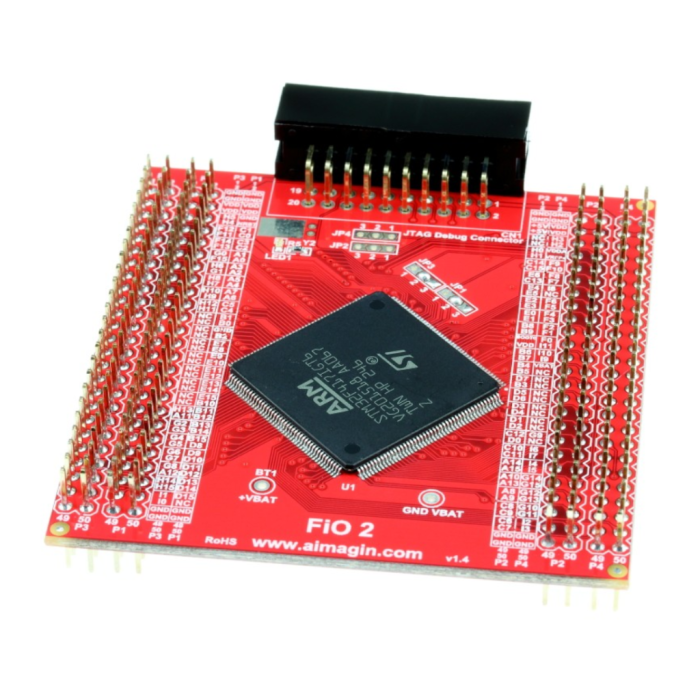FiO 2
Quick Overview
• Based on ARM Cortex-M4 STM32F417IG MCU
• All IO pins available via pin headers upto 140 pins
• Pin compatible with STM32F4DISCOVERY board
• Onboard 8MHz crystal (for HSE clock)
• JTAG Debugger port
• Require ST-Link to program and debug
• Optional External SDRAM (up to 512 kBytes)
• Optional Onboard 32.768kHz crystal (for real time clock) with button (2032) battery holder
**IMPORTANT NOTE**: FiO 2 requires ST Link to program the MCU.

Supported Matlab / Simulink Software (Waijung Blockset)
Tutorials:
• FiO2 and aMG Labkit – Blinky demo
• Other tutorials
SKU
aMG_P004
Out of stock
SKU
aMG_P004
฿2,000.00
STM32F417IG Features
Core: ARM 32-bit Cortex™-M4 CPU with Floating Point Unit, Adaptive real-time accelerator (ART Accelerator™) allowing 0-wait state execution from Flash memory, frequency up to 168 MHz, memory protection unit, 210 DMIPS/1.25 DMIPS/MHz (Dhrystone 2.1), and DSP instructions• Memories
– Up to 1 Mbyte of Flash memory
– Up to 192+4 Kbytes of SRAM including 64-Kbyte of CCM (core coupled memory) data RAM
– Flexible static memory controller supporting Compact Flash, SRAM, PSRAM, NOR and NAND memories
• LCD parallel interface, 8080/6800 modes
• Clock, reset and supply management
– 1.8 V to 3.6 V application supply and I/Os
– POR, PDR, PVD and BOR
– 4-to-26 MHz crystal oscillator
– Internal 16 MHz factory-trimmed RC (1% accuracy)
– 32 kHz oscillator for RTC with calibration
– Internal 32 kHz RC with calibration
• Low power
– Sleep, Stop and Standby modes
– VBAT supply for RTC, 20×32 bit backup registers + optional 4 KB backup SRAM
• 3×12-bit, 2.4 MSPS A/D converters: up to 24 channels and 7.2 MSPS in triple interleaved mode
• 2×12-bit D/A converters
• General-purpose DMA: 16-stream DMA controller with FIFOs and burst support
• Up to 17 timers: up to twelve 16-bit and two 32-bit timers up to 168 MHz, each with up to 4 IC/OC/PWM or pulse counter and quadrature (incremental) encoder input
• Debug mode – Serial wire debug (SWD) & JTAG interfaces – Cortex-M4 Embedded Trace Macrocell™
• Up to 140 I/O ports with interrupt capability – Up to 136 fast I/Os up to 84 MHz – Up to 138 5 V-tolerant I/Os
• Up to 15 communication interfaces
– Up to 3 × I2C interfaces (SMBus/PMBus)
– Up to 4 USARTs/2 UARTs (10.5 Mbit/s, ISO 7816 interface, LIN, IrDA, modem control)
– Up to 3 SPIs (37.5 Mbits/s), 2 with muxed full-duplex I2S to achieve audio class accuracy via internal audio PLL or external clock
– 2 × CAN interfaces (2.0B Active)
– SDIO interface
• Advanced connectivity
– USB 2.0 full-speed device/host/OTG controller with on-chip PHY
– USB 2.0 high-speed/full-speed device/host/OTG controller with dedicated DMA, on-chip full-speed PHY and ULPI
• 8- to 14-bit parallel camera interface up to 54 Mbytes/s
• Cryptographic acceleration: hardware acceleration for AES 128, 192, 256, Triple DES, HASH (MD5, SHA-1), and HMAC
• True random number generator
• CRC calculation unit
• 96-bit unique ID
• RTC: subsecond accuracy, hardware calendar
FiO 2 has been designed to be pin compatible with STM32F4DISCOVERY and fully compatible with aMG F4 Connect 2. If you plan to use FiO 2 without aMG F4 Connect 2, the following picture show minimum required connections.
1. Connect GND to connector P3, pin
2. Connect VDD (3.3V @HCLK=168MHz) to connector P3, pin 3.
3. Connect VREF+ to VDD (3.3V).
4. Connect VDDA to VDD (3.3V)
All VDD and GND on FiO 2 are connected together by designed and are intended for better distribution of VDD and GND.

Write Your Own Review





